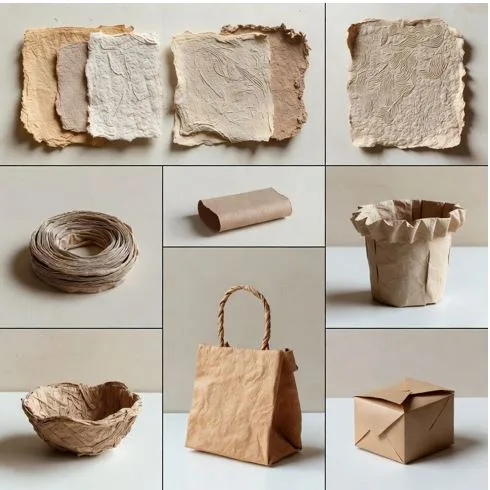Creative Uses for Recycled Paper: A Guide to Sustainable Living
- Introduction: Rethinking Our Relationship with Paper
Paper is everywhere, yet our modern use of it is unsustainable. Globally, we generate over 2.2 billion tons of waste each year, with paper making up 26% of that total. Many assume paper is inherently “eco-friendly” because it comes from trees, but this is a simplistic view.
Addressing this challenge requires a holistic approach: robust industrial recycling, creative individual reuse, and professional waste management. This guide explores how we can reduce waste, reuse creatively, and ensure paper gets a second life.
- The Hidden Cost of Paper Waste
Our paper habits have massive environmental consequences:
- Deforestation: Over 15 million hectares of forest are consumed annually for paper production—nearly a fifth of the Amazon rainforest.
- Landfill Volume: Paper accounts for roughly a quarter of global trash.
- Consumer Consumption: Over 80 billion rolls of toilet paper are used worldwide annually.
Clearly, responsible waste management is essential—not optional. Fortunately, industrial recycling exists to turn discarded paper into new, valuable products.
- How Recycled Paper is Made
Understanding how discarded paper becomes new products shows the importance of proper sorting and collection. The industrial journey has two main phases:
Phase 1: Sorting & Preparation
- Paper is collected from homes and businesses and taken to a material recovery facility.
- Contaminants like plastic and metal are removed using magnets, air separators, optical sensors, and manual checks.
- The clean paper is shredded and baled for transport to paper mills.
Phase 2: Pulping & Transformation
- At the mill, paper is mixed with water in a pulper, separating fibers and removing inks and adhesives.
- The slurry is pressed, dried, and smoothed into sheets.
- Sheets are rolled, cut, and converted into new products such as cardboard, notebooks, or toilet paper.
Learn more about how recycled paper is made and why proper sorting at the source is vital.
- The Responsibility Gap
Not all “recyclable” paper is actually recycled. Offices, warehouses, and large commercial facilities generate volumes too high for manual recycling. Without professional management, much of this paper ends up in landfills, closing off its potential for reuse.
This is where Commercial Rubbish Removal comes in. Professional services ensure bulk paper waste is collected responsibly and delivered directly to recycling centers, keeping it in the circular economy.
- The Science of Sustainability
Life Cycle Assessment (LCA) shows that environmental impact depends on more than material origin:
- Biodegradability Isn’t Enough: Paper in anaerobic landfills produces methane, a greenhouse gas far stronger than CO₂.
- Function Matters: A paper bag must be heavier than plastic to carry the same load, which can increase its overall environmental footprint.
True sustainability considers production, usage, disposal, and recycling together—moving beyond intuition toward scientifically informed choices.
- Characteristics of Truly Sustainable Paper
When choosing paper, look for:
- High recycled content
- Recyclability
- FSC certification
- Ethical sourcing
- Compostable and chemical-free production
These qualities ensure the paper supports circularity and minimizes environmental harm.
- Creative Ways to Reuse Paper at Home
Reusing paper creatively reduces waste and gives materials a second life. Some practical and inspiring ideas include:
Household Uses:
- Eco-friendly packing material
- Window and stainless-steel cleaning
- Drawer and shelf liners
- Fire starters and shoe deodorizers
Gardening & Composting:
- Biodegradable seed pots from newspaper or toilet rolls
- Natural weed barriers
- Carbon-rich addition for compost piles
Crafts & DIY Projects:
- Handmade paper, notebooks, and journals
- Unique gift wrap from old maps or magazines
- Papier-mâché sculptures and paper beads
Pets & Animals:
- Bedding for small animals
- Cat litter box liners
Innovative & Industrial Uses:
- Cellulose insulation for homes
- Molded protective packaging
- Fuel briquettes
- Educational models and teaching aids
These small actions, though simple, collectively reduce waste and foster participation in the circular economy.
- Professional Management for Large-Scale Paper Waste
Creative reuse works at the household level, but offices, warehouses, and other commercial sites generate much higher volumes of paper. For these cases, professional waste management is non-negotiable. Services like Commercial Rubbish Removal consolidate, sort, and transport bulk paper to recycling centers efficiently. This ensures materials enter the industrial recycling loop, preventing landfill waste and closing the “responsibility gap.”
- Reducing Paper Waste at the Source
The most impactful strategy is upstream prevention:
- Digital-first Approach: Minimize print jobs with electronic documents and cloud-based communication.
- Optimized Printing: Use double-sided printing policies to halve paper usage.
- Cultivate Sustainability Culture: Educate teams on mindful consumption.
- Track & Reduce: Monitor usage, set measurable reduction goals, and hold teams accountable.
When combined with proper recycling and creative reuse, these steps create a comprehensive approach to sustainable paper management.
- Conclusion: Building a Smarter Future with Paper
Sustainable paper use relies on three pillars:
- Industrial Recycling: Sophisticated processes turn massive waste into valuable new products.
- Creative Reuse: Individuals can reduce household waste and find new value in discarded materials.
- Professional Management: Businesses must partner with services like Commercial Rubbish Removal to handle high-volume waste responsibly.
By combining these strategies, we can use paper thoughtfully, reduce environmental impact, and participate in a circular economy that benefits both people and the planet.






